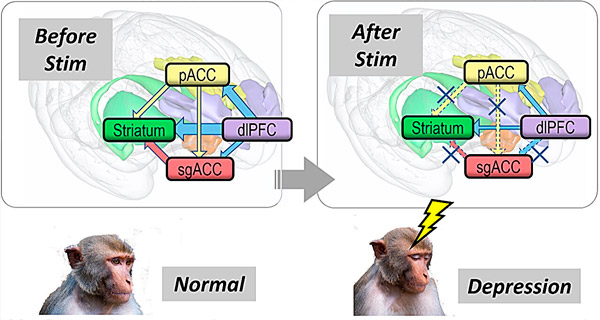
抑郁症是一种潜在的精神健康疾病,影响着全球数百万人。理解和治疗抑郁症仍然是神经科学研究人员的首要任务。例如,重度抑郁症(MDD) 影响着约 3300 万人,约占全球成年人口的 5%。
情绪调节是大脑中一项重要的功能,有助于抑制情绪和抑郁,并被认为是重度抑郁症的一种保护机制。然而,大脑调节抑郁症的神经生物学机制尚不清楚。
为了探究这个问题,最近由 Satoko Amemori 和 Ken-ichi Amemori 领导并发表在《自然通讯》杂志上的一项研究调查了特定大脑回路如何调节情绪反应,为抑郁症的神经基础提供了新的见解。
在这项研究中,研究人员聚焦于背外侧前额皮质(dlPFC),该区域长期以来被认为在情绪调节中发挥着重要作用。研究人员探究了抑郁症患者中dlPFC信号的变化,并阐明了dlPFC调控扣带回纹状体网络的机制。
揭示灵长类动物抑郁行为背后的神经机制可能为开发针对特定大脑回路的新治疗方法奠定基础。
这项研究考察了背外侧前额叶皮质(dlPFC)对扣带回纹状体网络(与抑郁症相关)在情绪调节中的所谓“自上而下的影响”。科学家们还研究了这些回路如何影响决策和情绪反应。
研究人员利用微刺激技术改变了恒河猴(Macaca mulatta)膝下前扣带皮层(sgACC)的神经活动,并能够通过实验诱发悲观决策和抑郁状态。
在这些刺激实验中,研究人员还记录了局部场电位(LFP),以分析 dlPFC 对扣带纹状体网络自上而下的影响。
他们发现,实验引发的悲观决策会伴随自上而下的扣带纹状体区域 dlPFC 输入的减少。
这一发现表明,从认知到情感的自上而下的信号中断可能会导致悲观的决策,这是 MDD 的一个特征。
这项研究的一项重要发现是β振荡在额纹状体回路中的作用。β振荡长期以来一直与运动控制和注意力相关,近年来,它们也与工作记忆等认知功能相关。
在这项新研究中,对 sgACC 进行有效的微刺激(会诱发抑郁状态)可降低编码与决策相关的正变量的 β 振荡的幅度。

Stim:微刺激;dlPFC:背外侧前额皮质;pACC:膝前前扣带皮层;sgACC:膝下前扣带皮层。
来源:《自然通讯》(2024)。DOI:10.1038/s41467-024-48375-1
这种 β 振荡的减少很重要,因为它表明 sgACC 活动和决策中的消极偏见之间存在联系,为大脑如何处理正面和负面价值提供了一种潜在的机制。
该研究还考察了额叶扣带回纹状体网络内各区域之间的相互作用。通过检验连贯性和格兰杰因果关系(一种统计检验,用于确定一个变量是否可以被有意义地描述为因变量)等因素,研究人员发现,对额叶扣带回的有效微刺激会改变这些相互作用,反映出该网络在决策过程中的参与。
他们发现,dlPFC 对扣带回纹状体网络的“自上而下的影响”是由 LFP 贝塔振荡编码的,而自上而下影响的减少与实验诱发的抑郁症有关。
这些发现强调了该网络在情绪调节和决策中的重要作用,以及其功能障碍如何导致抑郁行为。
这项研究为抑郁症的神经基础提供了宝贵的见解,强调了特定脑回路在调节情绪反应中的作用。重要的是,该研究创建了一个抑郁症灵长类动物模型,并表明额叶-扣带回-纹状体回路参与通过β振荡调节边缘系统。
重要的是,研究人员能够证明,即使缺乏这种调节,猴子也表现出抑郁行为。通过揭示灵长类动物抑郁行为的潜在机制,这项研究为开发更有效的重度抑郁症治疗方法开辟了新的途径。

